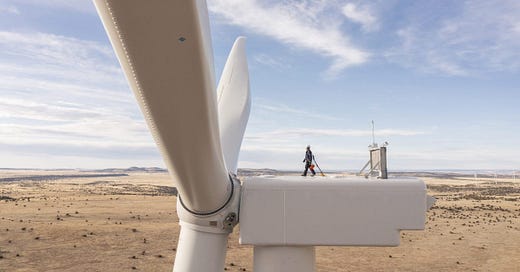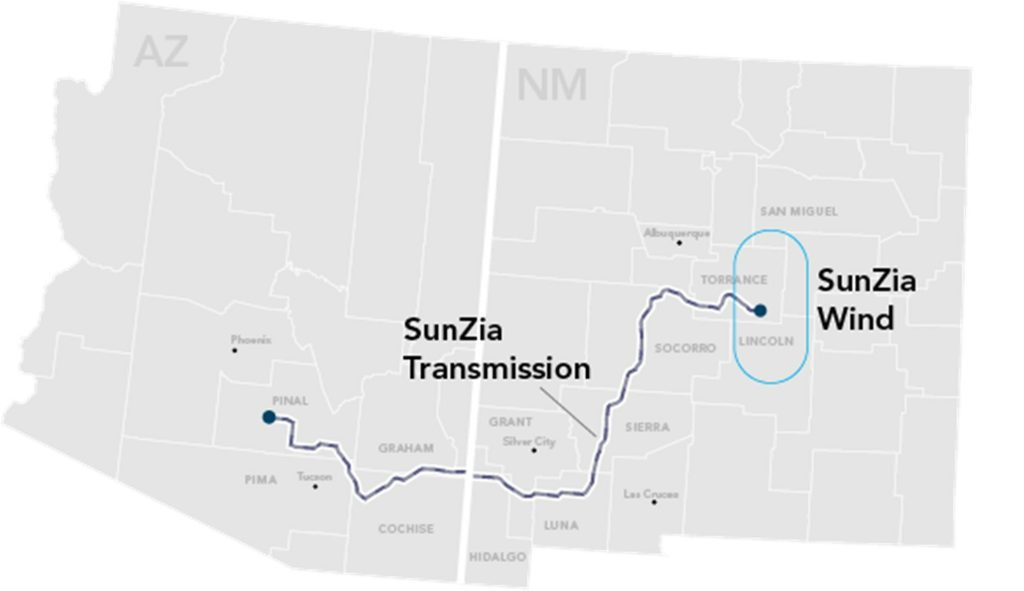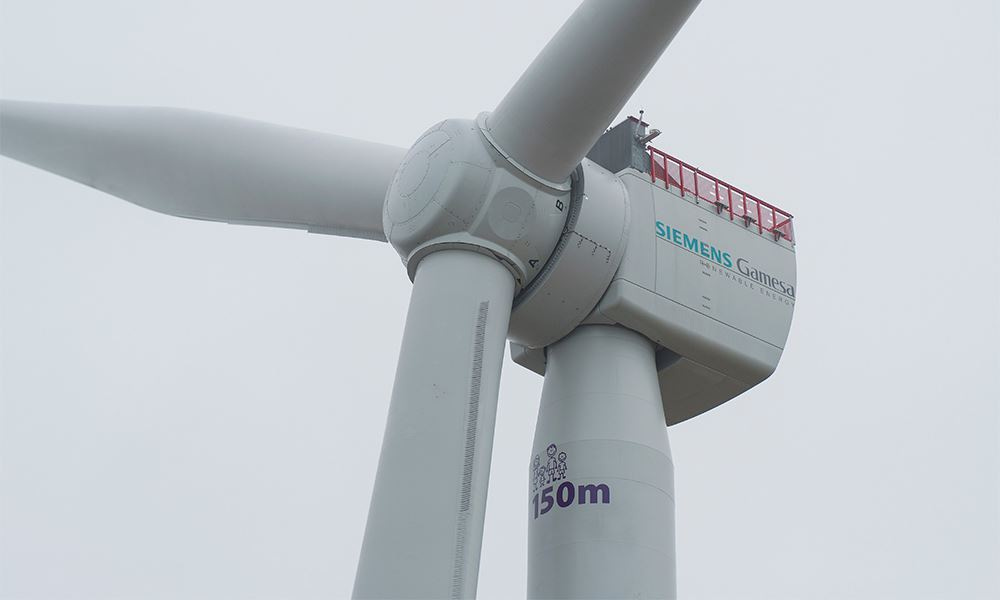Windletter #65 - One of the largest onshore contract in history
Also: Siemens Gamesa and the world's most powerful prototype, China also has dependencies in wind power, extension of milestones, concrete for European floating wind power, and more.
Hello everyone and welcome to a new issue of Windletter. I'm Sergio Fernández Munguía (@Sergio_FerMun) and here we discuss the latest news in the wind power sector from a different perspective. If you enjoy the newsletter and are not subscribed, you can do so here.
The most read from the last edition has been: the challenges of wind energy in Spain in 2024, the video of slacklining between two wind turbines, and the video of the first kilowatt hours from Vineyard Wind.
General Electric announces an onshore contract of 2.4 GW with Pattern Energy in the U.S.
General Electric has just announced in the United States what is probably the largest onshore contract in history (at least outside of China).
This involves an order for 674 units of the GE 3.6-154, the latest model from the American firm optimized for low winds. In fact, among Western manufacturers, only Vestas has something similar in its portfolio with the V155-3.6 MW, of which not many have been sold.
The wind turbines will be installed in the New Mexico desert, in the SunZia project for Pattern Energy. Although the agreement is for 2,400 MW, once completed, this project will have a total capacity of 3,500 MW, which, according to GE itself, will make it the largest wind farm in the "Western Hemisphere."
The remaining 1,100 MW of the project have been awarded to Vestas, which recently announced the signing of the largest onshore project to date in the U.S. market. This time, the contract is for a quite different wind turbine, the V163-4.5 MW, of which Vestas will supply 242 units. I am not aware of...
As an interesting fact, it is worth mentioning that SunZia will transport the generated electricity through a high-voltage direct current (HVDC) cable to Phoenix, where the energy can be further sent to the markets in Arizona and California. The cable will be an impressive 885 km long with a voltage of 525 kV. In essence, it does not differ much from an offshore project in terms of complexity, capacity, and evacuation infrastructure. It even surpasses many.
Of course, these wind turbines will have a significant portion of local manufacturing, allowing them to take advantage of the IRA tax incentive program.
👉 Without delving too deeply into research, I would say that this contract is the largest onshore order in history (as a single wind farm and a single contract), or at least I don't recall anything similar. Although, there are probably "mega-contracts" in China of which we are not even aware of their existence.
_
Siemens Gamesa to install the world's most powerful offshore wind turbine prototype
According to reports from Windpowermonthly and other specialized media, Siemens Gamesa plans to install what it claims to be the prototype of the world's most powerful offshore wind turbine.
So far, SGRE has not confirmed the nominal power or rotor diameter, but if true, their statements suggest that this prototype will be more powerful than the 16 MW machine that China's Mingyang Smart Energy installed last summer and, of course, more powerful than the Goldwind GWH252-16 MW.
It is also not clear whether this SGRE model will be more powerful than the recent announcements from China (which do not yet have a prototype), ranging around 18 MW, and also from General Electric, or even the 22 MW machine with a rotor diameter of 310 meters recently announced by Mingyang.
The little information known about the SGRE project is thanks to the data published by the European Commission through the Innovation Funds, as this project has secured 30 million in funding.
According to the project presentation document for HIPPOW (Highly Innovative Prototype of the most Powerful Offshore Wind turbine generator), innovative technologies related to nominal power, bearings, electrical system, blade and tower installation, cooling system, and maintenance strategy will be tested.
As per this document, the prototype should be operational by December 31 of this year, so SGRE should have the project well underway by now. The installation site will be the Østerild Test Center in Denmark, where Vestas and Siemens Gamesa test most of their prototype turbines, both onshore and offshore.
Considering the pace of developments, especially in China, SGRE will need to hurry to make these statements a reality.
_
China continues to depend on third countries for the supply of key wind power technologies
Despite recent discussions about the Western (especially European) renewable supply chain's dependence on China, the reality is that the Asian giant also relies on third countries for certain key components.
At least that's what a report from Tsinghua University claims, stating that China has to import many elements from third countries for the development and manufacturing of its wind turbines. Some examples include:
Software for design and simulation
60% of main bearings in turbines over 5 MW
70% of IGBTs used in converters (this is quite surprising)
PLCs are supplied by foreign companies
Carbon fiber mainly comes from Japan and the United States
95% of lubricants and oils
Indeed, these situations seem common in a globalized world, but it's good to have this perspective to avoid thinking that "the grass is always greener on the other side."
_
The challenges of Spanish wind power in 2024
A very insightful interview by Milena Giorgi with Juan Virgilio (CEO of AEE) on Energía Estratégica España. In it, a review is made of the main challenges facing the wind power sector in Spain for 2024.
Some highlights:
The low electricity demand is concerning.
If there is no auction in 2024, there will be no offshore wind power by 2030.
If we do not accelerate the permitting process for wind power, we will not meet the objectives of the PNIEC.
The challenge of social opposition.
Repowering of parks and its challenges.
The full interview can be found on Energía Estratégica.
_
Extension of milestones for renewable development approved at the last minute
In the previous edition, we briefly mentioned that the government was going to extend some of the administrative milestones that are a bottleneck for the development of many renewable gigawatts in Spain.
Finally, the decree has been approved at the last minute, so the extension of these deadlines is now official. To better understand what this project implies, the best source I found is this publication by NTeaser.
Although the sector's reception has been generally positive, Javier Revuelta, always precise in his analyses, pointed out in this LinkedIn comment that this law also brings some negative impacts for many assets, both existing and future.
Basically, Javier mentions that a greater number of projects connected in the future also means lower prices in the wholesale market, resulting in lower revenues for projects with market exposure.
Now, some renewable projects can take up to 8 years from the start of the process to commercial operation, with all the associated development costs. It seems that the administration is giving itself more time as it cannot handle all the projects in permitting process.
On the other hand, the maximum total processing time for offshore wind farms and hydroelectric pumping has been set at nine years.
_
Why concrete is the way for European offshore wind power
In the design of floating platforms for offshore wind turbines, there is a technological battle between steel and concrete. Although, based on current installations, it seems that steel is winning the battle, probably due to its ease of industrialization compared to concrete, which requires much more labor-intensive work and is more "artisanal."
Among the more mature and operational steel designs are:
The semi-submersible from KinCardine
The semi-submersible from WindFloat Atlantic
The spar from Hywind Scotland
The semi-submersible from Provence Grand Large
The semi-spar TetraSpar from Stiesdal
The TLP PivotBuoy from X1Wind
Among the more mature and operational concrete designs are:
The spar from Hywind Tampen
The barge DemoSATH from Saitec Offshore
The barge from BW Ideol
…
In an interview with Paul de la Guérivière, CEO of BW Ideol, in Windpower Monthly, he points out that concrete is the only way for European floating wind power at the moment:
"We are totally convinced that the only way to deliver a 1 GW floating wind project in Europe is to have a concrete floater because there is no way you can manufacture 1 GW of steel semisubmersible floaters in Asia with final assembly in Europe and deliver it in less than three years. There is no way you can do that."
_
Vineyard Wind generates its first kilowatt-hour
Vineyard Wind is an offshore wind farm developed by Avangrid (Iberdrola) and CIP (Copenhagen Infrastructure Partners) in the U.S. It consists of 62 General Electric Haliade-X turbines with a capacity of 13 megawatts each, totaling 806 MW of capacity. And it has just generated its first kilowatt-hour.
Specifically, it did so on January 2nd, as announced on social media with a short video of the first turns of turbine number 38.
Vineyard Wind is the first large-scale offshore wind farm in the U.S., which until now only had two small projects:
Block Island, installed in 2016 and composed of 6 Alstom Haliade 150-6 MW turbines.
Coastal Virginia Offshore Wind, installed in 2020 and composed of 2 Siemens Gamesa SWT-6.0-154 turbines.
The offshore sector in the U.S. is currently a bit turbulent, with several projects canceled and/or frozen awaiting better times.
Just recently, Equinor and BP broke their agreement to sell power to the state of New York from their 260.2 MW Empire Wind 1 offshore wind farm. Last year, Ørsted also canceled two large offshore wind projects in New Jersey, which had a significant impact on its stock price.
_
A court decision forces Enel to dismantle 84 wind turbines
This news has gone somewhat unnoticed in the wind power world, but it's a bombshell. Enel will have to dismantle 84 wind turbines (150.4 MW) in Osage County, United States, after losing a 12-year legal battle against the local tribe.
Apparently, Enel used rock from the area's subsurface during the park's construction without permission, which is owned by the locals.
More details about this story from a critical perspective can be found in this article by Robert Bryce.
_
Slacklining between two Enercon wind turbines
The curiosity of this edition comes from Nathan Paulin and his extraordinary balance. Some of you may be familiar with the practice of slacklining and may have even tried it before. It involves balancing on a tightrope, usually tied between two trees.
What's the shortest path to get from one nacelle to another? The straight line.
So, Frenchman Nathan Paulin had the idea that it was a good idea to balance on a slackline between the nacelles of two Enercon wind turbines. The video is from 2022, but it's worth taking a look.
👉 If just looking down from the top of a nacelle is already scary enough, I can't even imagine what it must feel like to do this...
Thank you very much for reading Windletter. If you enjoyed it, I invite you to subscribe, leave a ❤️, forward it by email, share it on social media, or recommend it to others.
You can follow Windletter's profiles on Twitter and LinkedIn. Also, if you enjoy reading about energy, check out Windletter's Library.
You can also contact me through my Twitter or LinkedIn profiles.
See you in the next one!
Disclaimer: The opinions presented in Windletter are mine and do not necessarily reflect the views of my employer.










